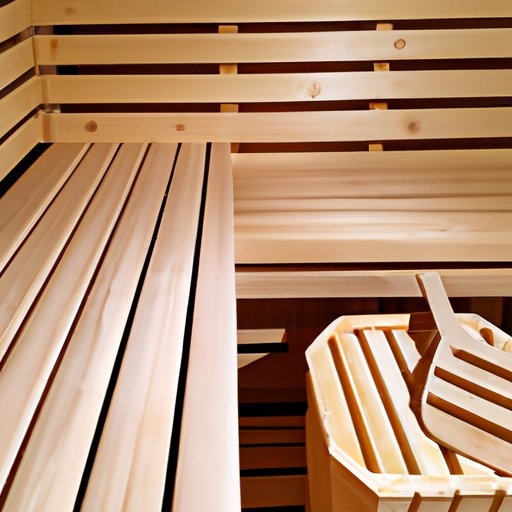
Introduction
A sauna is a small room or house designed specifically for heat sessions, mainly associated with relaxation, detoxification, and other health benefits. This traditional Finnish invention has become increasingly popular worldwide, and more and more people are now opting to build their own sauna at home. If you’re looking to construct your own sauna but don’t know where to start, you’ve come to the right place! This article will provide an in-depth guide on how to build a sauna from scratch, including planning, materials and tools, DIY vs. hiring a professional, health benefits, customization, and maintenance.
Step-by-Step Guide
The first step to building a sauna is to determine its location and size. You can choose to build your sauna indoors or outdoors, depending on your preference and availability of space. Once you’ve decided on the location, you need to measure the dimensions of the room and draw a rough plan. Next, you’ll need to gather the necessary materials and tools, which include:
- Cedar wood or other sauna-grade lumber
- Sauna heater—electric, wood-burning, or gas
- Sauna stones or rocks
- Sauna door and window (if applicable)
- Insulation—fiberglass, foam, or mineral wool
- Aluminum foil vapor barrier
- Thermometer and hygrometer
- Buckets and ladles
Once you’ve gathered all the necessary materials and tools, you can begin the construction process. Here are the general steps involved in building a sauna:
- Frame the walls and add insulation
- Add vapor barrier and foil
- Add the benches, heater, and stones
- Install the door and window (if applicable)
- Ventilate the room
- Decorate and add finishing touches
DIY vs. Hiring a Professional
Building a sauna can be a fun and rewarding DIY project, but it does require some skills and experience. Leaving the job to a professional can save you time and effort, but it will definitely cost you more money. Here are the pros and cons of building your own sauna versus hiring a professional:
- DIY
- Pros: Save money, control over the project, personalized design, learn new skills
- Cons: Time-consuming, potential mistakes, safety hazards, limited knowledge and expertise
- Hiring a Professional
- Pros: Professional results, save time, guaranteed quality, safety compliance
- Cons: Expensive, less control, limited customization options
If you’re confident in your skills and experience, building your own sauna can be a great way to save money and tailor the design to your preferences. However, if you lack the necessary expertise, it’s best to leave the job to a qualified professional.
Health Benefits of a Sauna
A sauna offers a wide range of physical and mental health benefits, including:
- Detoxification—sweating helps rid the body of toxins and pollutants
- Stress relief—sauna sessions promote relaxation and reduce stress levels
- Pain relief—heat can help alleviate muscle and joint pain
- Better sleep—sauna sessions can improve sleep quality and duration
- Improved circulation—heat increases blood flow and oxygenation
If you decide to build your own sauna, you can maximize these benefits by incorporating additional features such as chromotherapy lighting, aroma dispensers, and music systems. However, it’s important to use the sauna safely and avoid overexposure to heat, which can lead to heat exhaustion or other health issues. Here are some guidelines to follow:
- Stay hydrated—drink plenty of water before, during, and after sauna sessions
- Limit session duration—20-30 minutes is usually recommended
- Take breaks—cool down in between sessions by taking a cold shower or stepping outside
- Monitor your symptoms—if you feel dizzy, nauseous, or unwell during a session, leave the sauna immediately
Sauna Design and Customization
Building your own sauna means you have full control over its design and customization. You can choose from a variety of styles, sizes, and materials, depending on your preferences and budget. Here are some popular sauna designs and sizes:
- Traditional Finnish sauna—rectangular, wood-paneled, typically 4-8 people
- Banya-style sauna—round, all-wood construction, typically 8-12 people
- Infrared sauna—uses infrared radiation instead of convection heat, typically 1-2 people
The most common materials used for saunas are cedar wood, Nordic spruce, aspen, and hemlock. Each wood has its unique characteristics and benefits, such as aroma, durability, and resistance to moisture. In addition to wood, you can also customize your sauna by adding lighting, seating arrangements, and accessories such as towel racks and cup holders.
Best Practices for Sauna Maintenance
Maintaining your sauna is crucial to ensure its longevity and safety. Here are some tips on how to clean and maintain your sauna:
- Wipe down the benches and walls with a dry or damp cloth after use
- Regularly inspect the heater, stones, and temperature controls for any signs of damage or malfunction
- Deep-clean the sauna at least once a year, using a mild detergent or sauna cleaner
- Replace the stones periodically, as they can weaken or break down over time
- Keep the sauna well-ventilated to prevent moisture buildup and mold growth
Conclusion
Building your own sauna can be a fun and rewarding project that allows you to reap the health benefits of sauna sessions in the comfort of your home. Whether you decide to DIY or hire a professional, there are many factors to consider, such as materials, design, customization, and maintenance. By following the guidelines and tips provided in this article, you can build a sauna that meets your specific needs and preferences.




